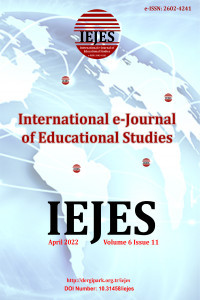Student Ability for Learning Computer Programming Languages in Primary Schools
Learning programming, educational technology, computer programming languages
Student Ability for Learning Computer Programming Languages in Primary Schools
___
- Ala-Mutka, K. (2004). Problems in learning and teaching programming–a literature study for developing visualizations in the Codewitz-Minerva project. Codewitz needs analysis, 20.
- Bargury, I. Z., Muller, O., Haberman, B., Zohar, D., Cohen, A., Levy, D., & Hotoveli, R. (2012). Implementing a new Computer Science Curriculum for middle school in Israel. Paper presented at the Frontiers in Education Conference (FIE), 2012.
- Bers, M. U., Flannery, L., Kazakoff, E. R., & Sullivan, A. (2014). Computational thinking and tinkering: Exploration of an early childhood robotics curriculum. Computers & Education, 72, 145-157.
- Clements, D. H., & Gullo, D. F. (1984). Effects of computer programming on young children's cognition. Journal of Educational Psychology, 76(6), 1051.
- Denner, J., Werner, L., & Ortiz, E. (2012). Computer games created by middle school girls: Can they be used to measure understanding of computer science concepts? Computers & Education, 58(1), 240-249. doi:https://doi.org/10.1016/j.compedu.2011.08.006
- Fessakis, G., Gouli, E., & Mavroudi, E. (2013). Problem solving by 5–6 years old kindergarten children in a computer programming environment: A case study. Computers & Education, 63, 87-97. doi:https://doi.org/10.1016/j.compedu.2012.11.016
- Grgurina, N., Barendsen, E., Zwaneveld, B., van Veen, K., & Stoker, I. (2014). Computational thinking skills in dutch secondary education: exploring teacher's perspective. Paper presented at the Proceedings of the 9th workshop in primary and secondary computing education.
- Grout, V., & Houlden, N. (2014a). Taking Computer Science and Programming into Schools: The Glyndŵr/BCS Turing Project. Procedia - Social and Behavioral Sciences, 141, 680-685. doi:https://doi.org/10.1016/j.sbspro.2014.05.119
- Grout, V., & Houlden, N. (2014b). Taking computer science and programming into schools: The Glyndŵr/BCS Turing project. Procedia-Social and Behavioral Sciences, 141, 680-685. Kalelioğlu, F. (2015). A new way of teaching programming skills to K-12 students: Code. org. Computers in Human Behavior, 52, 200-210.
- Kalelioğlu, F., & Gülbahar, Y. (2014). The effects of teaching programming via scratch on problem solving skills: a discussion from learners' perspective. Informatics in Education, 13(1).
- Kaučič, B., & Asič, T. (2011). Improving introductory programming with Scratch? Paper presented at the MIPRO, 2011 Proceedings of the 34th International Convention.
- Kelleher, C., Pausch, R., & Kiesler, S. (2007). Storytelling alice motivates middle school girls to learn computer programming. Paper presented at the Proceedings of the SIGCHI conference on Human factors in computing systems.
- Keren, G., & Fridin, M. (2014). Kindergarten Social Assistive Robot (KindSAR) for children’s geometric thinking and metacognitive development in preschool education: A pilot study. Computers in Human Behavior, 35, 400-412. doi:https://doi.org/10.1016/j.chb.2014.03.009
- Lee, I., Martin, F., & Apone, K. (2014). Integrating computational thinking across the K--8 curriculum. Acm Inroads, 5(4), 64-71.
- Lin, J. M.-C., Yen, L.-Y., Yang, M.-C., & Chen, C.-F. (2005). Teaching computer programming in elementary schools: A pilot study. Paper presented at the National educational computing conference.
- Mohammed, G. S., Wakil, K., & Nawroly, S. S. (2018). The Effectiveness of microlearning to improve students’ learning ability. International Journal of Educational Research Review, 3(3), 32-38.
- Nawzad, L., Rahim, D., & Said, K. W. (2018). The Effectiveness of Technology for Improving the Teaching of Natural Science Subjects. Indonesian Journal of Curriculum and Educational Technology Studies, 6(1), 15-21.
- Rico, M., Martínez-Muñoz, G., Alaman, X., Camacho, D., & Pulido, E. (2011). A programming experience of high school students in a virtual world platform. International Journal of Engineering Education, 27(1), 52.
- Robins, A., Rountree, J., & Rountree, N. (2003). Learning and teaching programming: A review and discussion. Computer Science Education, 13(2), 137-172.
- Rogozhkina, I., & Kushnirenko, A. (2011). PiktoMir: teaching programming concepts to preschoolers with a new tutorial environment. Procedia-Social and Behavioral Sciences, 28, 601-605.
- Roy, G. G., Kelso, J., & Standing, C. (1998). Towards a visual programming environment for software development. Paper presented at the Software Engineering: Education & Practice, 1998. Proceedings. 1998 International Conference.
- Saeli, M. (2012). Teaching programming for secondary school: a pedagogical content knowledge based approach. Technische Universiteit Eindhoven.
- Sáez-López, J.-M., Román-González, M., & Vázquez-Cano, E. (2016). Visual programming languages integrated across the curriculum in elementary school: A two year case study using “Scratch” in five schools. Computers & Education, 97, 129-141.
- Stephenson, C., Gal-Ezer, J., Haberman, B., & Verno, A. (2005). The new educational imperative: Improving high school computer science education. Final Report of the CSTA Curriculum Improvement Task Force. Wakil, K., & Jawawi, D. N. (2017). Comparison between web engineering methods to develop multi web applications. Journal of Software, 12(10), 783-794. Wakil, K., Muhamad, D., Sardar, K., & Jalal, S. (2017). The impact of teaching ICT for developing education systems. International Journal of Advanced Research (IJAR), 5(7), 873-879. doi:10.21474/IJAR01/4793.
- Wakil, K., Omer, S., & Omer, B. (2017). Impact of computer games on students GPA. European Journal of Education Studies. 3 (8), 262-272. doi:10.5281/zenodo.827400.
- Wakil, K., Qaisar, N.., & Mohammed, C. (2017). Enriching classrooms with technology in the basic schools. European Journal of Open Education and E-learning Studies, 2(1), 99-108.
- Winslow, L. E. (1996). Programming pedagogy—a psychological overview. ACM Sigcse Bulletin, 28(3), 17-22.
- Başlangıç: 2017
- Yayıncı: Tamer KUTLUCA
Relationship between Emotional Intelligence and Exam Anxiety of Higher Secondary Students
Effectiveness of Double Entry Journals Strategies Learning to Write Text Description
Raden Ahyar PROBOGATI, Kastam SYAMSI
Lecturer Resource Development Management at STKIP Bina Bangsa Getsempena Banda Aceh
İsthifa KEMAL, Suryadi SURYADI, Unifah ROSYIDI
Diyan Riski PERMATAHATI, Muhammad Nur WANGID
Student Ability for Learning Computer Programming Languages in Primary Schools
Karzan WAKIL, Shanaz KHDIR, Lava SABIR, Lezan NAWZAD
Guli SHERVASHIDZE, Tamar SIRADZE, Lela TAVDGIRIDZE, Nani MAMULADZE
